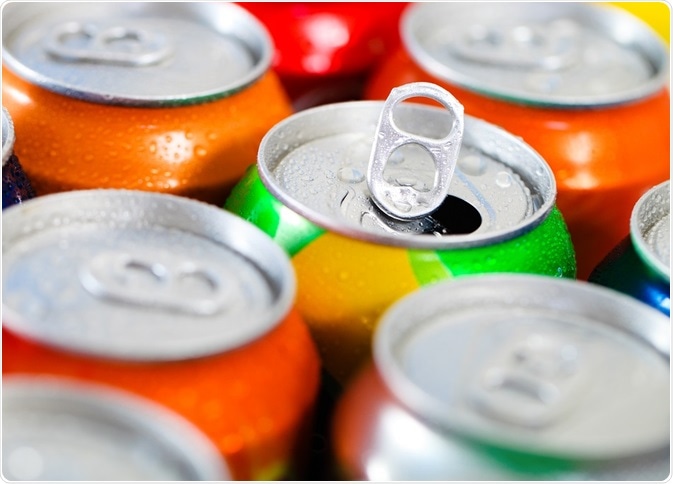Bisphenol A, also known as BPA, is one of the chemicals used for the manufacture of resins and plastic compounds. Polycarbonate is a high-quality transparent and rigid plastic that is produced using BPA. Baby bottles, beverage bottles, tableware, and storage containers are some of the examples of polycarbonate products.

Image Credit: Dasha Petrenko/ Shutterstock.com
In addition, BPA is used in manufacturing epoxy resins that are used in the lining and coatings of beverage cans or food products. Hence, the BPA chemical is possibly transferred in small amounts to beverages and foods.
The European Food Safety Authority (EFSA) is an organization whose primary task is to collect scientific data from experts and analyze the substances included in the manufacture of products that come into contact directly with foodstuffs and other beverages.
It is the main organization communicating to the public about the possible risks related to unsafe food. EFSA also provides advice and coordinates with international bodies, EU countries, and other agencies on the subject of food safety.
Background of EFSA on BPA
January 2007: The EFSA re-evaluated BPA from a group of expert studies carried out since 2002 and from studies in mice. After evidence was found by scientists about the limits of exposure of BPA in the human body, EFSA fixed the tolerable daily intake (TDI) level at 0.05 mg per kilogram of bodyweight.
The expert group of EFSA proved that the lower dose of BPA in rodents is not robust. BPA exposure in the human body, for both adults and children through foods, is much lower than the newly-set TDI.
July 2008: In 2008, EPSA reconfirmed its existing position that products extracted from BPA-based polycarbonates such as water bottles, containers, and epoxy contacted foods are safe for use by all age groups. The BPA intake level (TDI) provides the safety margin to protect consumer health.
There are many authorities including the European Commission’s Joint Research Centre, the US NTP, the Norwegian Scientific Committee for Food Safety, and Health Canada who recently reviewed the reassessment done by EFSA.
They are a panel group focused on the mechanism to remove BPA from the body. They concluded that the human body immediately metabolizes BPA in the human body. Human fetal exposure to BPA is insignificant due to the rapid metabolism of the mother’s body.
Similarly, newborns are also able to eliminate BPA from their body through metabolism of doses less than 1 mg per kilogram of body weight within a day.
June 2009: Until the year 2009, there were no studies based on criticisms of the position of EFSA on the findings of safe intake of BPA.
May 2010: The EFSA's aim is to update their previous stance regarding the safety of BPA as well as the new research data, including the study of neurodevelopmental factors and the risk of BPA put forward by other organization bodies.
January 17, 2014: The American Chemistry Council also supported the release of reaffirmations about the safety of BPA exposure by EFSA. EFSA finally announced in 2014 that BPA exposure in the human body from various sources is below the margin of safety intake level of BPA set up by government bodies.
Other organizational support of EFSA’s opinion on BPA
There are many government organizations in the world that have studied and evaluated the effects of BPA exposure on the human body. Organizations such as the U.S. Food and Drug Administration (FDA) have updated their position recently that BPA is safe for use at lower levels. Previously, FDA was against using BPA-based products, but after comprehensive reexamination, they concluded BPA is safe. The FDA's current position aligns with the position of EFSA.
U.S. government laboratories have supported the position of FDA and EFSA; recently FDA along with the government's Pacific Northwest National Laboratory (GPNNL) and the Centers for Disease Control and Prevention have conducted wide research on the risk of BPA in humans and animals. They have found that due to the metabolism of BPA in the body, there is a lower chance of health issues developing from exposure to any level of BPA in the body.
Current position of EFSA on BPA
Recently, EFSA has released new data that BPA may affect the immune system of animals, while there is significant evidence that it affects the human immune system. This result was found after complete re-evaluation of the toxicity and exposure from BPA. EFSA is continuing in its efforts to study and analyze the methodologies to reduce the TDI level against the toxicity of BPA.
Reviewed by Catherine Schaffer, M.Sc.
References
- https://europa.eu/european-union/about-eu/agencies/efsa_en
- http://www.efsa.europa.eu/en/topics/topic/bisphenol
- https://www.americanchemistry.com/Media/PressReleasesTranscripts/ACC-news-releases/EFSA-Draft-Opinion-Finds-BPA-Exposure-Levels-Lower-Than-Previously-Reported.html
- https://factsaboutbpa.org/safety-assessments/european-food-safety-authority
- http://www.foodpackagingforum.org/news/efsa-scientific-opinion-bpa-exposure-of-no-risk-to-consumers
- https://www.food.gov.uk/science/bpa/efsa-bpa-consultation#
Further Reading
- All Bisphenol A (BPA) Content
- Bisphenol A (BPA): The FDA’s Position
- Bisphenol A (BPA) Health Effects
- Link between Bisphenol A and Increase in Blood Pressure
- Reducing exposure to bisphenol A (BPA)
Last Updated: Jan 26, 2021
Source: Read Full Article
